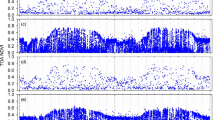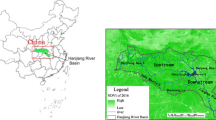Abstract
To study impact of climate change on vegetation time series vegetation index has a vital role to know the behaviour of vegetation dynamics over a time period. INSAT 3A CCD (Charged Couple Device) is the only geostationary sensor to acquire regular coverage of Asia continent at 1 km × 1 km spatial resolution with high temporal frequency (half-an-hour). A formulation of surface reflectances in red, near infrared (NIR), short wave infrared (SWIR) and NDVI from INSAT 3A CCD has been defined and integrated in the operational chain. The atmospheric correction of at-sensor reflectances using SMAC (Simple Model for Atmospheric Correction) model improved the NDVI by 5–40% and also increased its dynamic range. The temporal dynamics of 16-day NDVI composite at 0500 GMT for a growing year (June 2008–March 2009) showed matching profiles with reference to global products (MODIS TERRA) over known land targets. The root mean square deviation (RMSD) between the two was 0.14 with correlation coefficient (r) 0.84 from 200 paired datasets. This inter-sensor cross-correlation would help in NDVI calibration to add continuity in long term NDVI database for climate change studies.





Similar content being viewed by others
References
Bhattacharya, B. K., & Pandya, M. R. (2007). INSAT geophysical parameter retrieval system algorithm theoretical basis definition (pp. 269–284). Ahmedabad: Space Applications Centre, ISRO.
Dutta, S. K., Das, S., Kar, S., Mohanty, U. C., & Joshi, P. C. (2009). Impact of vegetation on the simulation of seasonal monsoon rainfall over the Indian subcontinent using a regional model. Journal of Earth System Science, 118, 413–440.
Fensholt, R., Sandholt, I., & Rasmussen, M. S. (2004). Evaluation of MODIS LAI, fAPAR and the relation between fAPAR and NDVI in a semi-arid environment using in situ measurements. Remote Sensing of Environment, 91, 490–507.
Fensholt, R. I., Sandholt, I., Stisen, S., & Tucker, C. (2006). Analysing NDVI for the African continent using the geostationary meteosat second generation SEVRI sensor. Remote Sensing of Environment, 101, 212–229.
Field, C. B., Randerson, J. T., & Malmstrom, C. M. (1995). Global net primary production: combining ecology and remote sensing. Remote Sensing of Environment, 51, 74–88.
Hasegawa, K., Matsuyama, H., Tsuzuki, H., & Sweda, T. (2010). Improving the estimation of leaf area index by using remotely sensed NDVI with BRDF signatures. Remote Sensing of Environment, 114, 514–519.
Huete, A., Didan, K., Miura, T., Rodriguez, E. P., Gao, X., & Ferreira, L. G. (2002). Overview of the radiometric and biophysical performance of the MODIS vegetation indices. Remote Sensing of Environment, 83, 195–213.
Jarlan, L., Mangiarott, S., Mougin, E., Mazzega, P., Hiernaux, P., & Le Dantec, V. (2008). Assimilation of SPOT/VEGETATION NDVI data into a sahelian vegetation P. dynamics model. Assimilation of SPOT/VEGETATION NDVI data into a sahelian vegetation dynamics model. Remote Sensing of Environment, 112, 1381–1394.
Matsushita, B., & Tamura, M. (2002). Integrating remotely sensed data with an ecosystem model to estimate net primary productivity in East Asia. Remote Sensing of Environment, 81, 58–66.
Miura, T., Yoshioka, H., Fujiwara, K., & Yamamoto, H. (2008). Inter-comparison of ASTER and MODIS surface reflectance and vegetation index products for synergistic applications to natural recourses monitoring. Sensors, 8, 2480–2499.
Nemani, R. R., Keeling, C. D., Hashimoto, H., Jolly, W. M., Piper, S. C., Tucker, C. J., et al. (2003). Climate-driven increases in global terrestrial net primary production from 1982 to 1999. Science, 300, 1560–1563.
Pielke, R. A., Marland, G., Betts, R. A., Chase, T. N., Eastman, J. L., Niles, J. O., et al. (2002). The influence of land-use change and landscape dynamics on the climate system: relevance to climate-change policy beyond the radiative effect of greenhouse gases. Philosophical Transactions of the Royal Society A, 360, 1705–1719.
Proud, S. R., Rasmussen, M. O., Fensholt, R., Sandholt, I., Shisanya, C., & Mutero, W. (2010) Improving the SMAC atmospheric correction code by analysis of Meteosat Second Generation NDVI and surface reflectance data. Remote Sensing of Environment, 114, 1687–1698
Rahman, H., & Dedieu, G. (1994). SMAC: a simplified method for the atmospheric correction of satellite measurements in the solar spectrum. International Journal of Remote Sensing, 15, 123–143.
Sakamoto, T., Yokozawa, M., Toritani, H., Shibayama, M., Ishitsuka, N., & Ohno, H. (2005). A crop phenology detection method using time-series MODIS data. Remote Sensing of Environment, 96, 366–374.
Sellers, P. J. (1985). Canopy reflectance, photosynthesis and transpiration. International Journal of Remote Sensing, 6, 1355–1372.
Spanner, M. A., Pierce, L. L., Running, S. W., & Peterson, D. L. (1990). The seasonality of AVHRR data of temperate coniferous forests: relationship with leaf area index. Remote Sensing of Environment, 33, 97–112.
Tanre, D., Deroo, C., Duhaut, P., Herman, M., & Morcrette, J. J. (1990). Description of a computer code to simulate the satellite signal in the solar spectrum-the 5S code. International Journal of Remote Sensing, 11, 659–668.
Tucker, C. J. (1979). Red and photographic infrared linear combinations for monitoring vegetaion. Remote Sensing of Environment, 8, 127–150.
Tucker, C. J., Justice, C. O., & Prince, S. D. (1986). Monitoring the grasslands of the Sahel 1984–1985. International Journal of Remote Sensing, 7, 1571–1571.
van Leeuwen, W. J. D., Orr, B. J., Marsh, S. E., & Herrmann, S. M. (2006). Multi-sensor NDVI data continuity: uncertainties and implications for vegetation monitoring applications. Remote Sensing of Environment, 100, 67–81.
Wang, Q., Adikua, S., Tenhunena, J., & Granier, A. (2005). On the relationship of NDVI with leaf area index in a deciduous forest site. Remote Sensing of Environment, 94, 244–255.
Wardlow, B. D., & Egbert, S. L. (2008). Large-area crop mapping using time-series MODIS 250 m NDVI data: an assessment for the U.S. Central Great Plains. Remote Sensing of Environment, 112, 1096–1116.
Wiegand, C. L., Richardson, A. J., & Kanemasu, E. T. (1979). Leaf area index estimated for wheat from Landsat and their implications for evapotranspiration and crop modeling. Agronomy Journal, 71, 336–342.
Wiegand, C. L., Richardson, A. J., Escobar, D. E., & Gerberman, A. H. (1991). Vegetation indices in crop assessments. Remote Sensing of Environment, 35, 105–119.
Zhang, X., Friedl, M. A., Schaaf, C. B., Strahler, A. H., Hodges, J. C. F., Gao, F., et al. (2003). Monitoring vegetation phenology using MODIS. Remote Sensing of Environment, 84, 471–475.
Acknowledgments
The authors are extremely grateful to Satellite Meteorology Division, IMD, New Delhi for providing the time series INSAT 3A CCD data from IMDPS in the purview of IMD-ISRO project. The authors would like to thank Dr. R.R. Navalgund, Director, Space Applications Centre (SAC), ISRO for his support given for this study. The authors would also like to thank Shri. A.S. Kiran kumar, Associate Director, SAC and Dr. J.S. Parihar, Deputy Director EPSA, SAC for their timely help during this study. The authors are grateful to Dr Sushma Panigrahy, Group Director, Agriculture, Terrestrial Biosphere and Hydrology Group for her valuable suggestions while carrying out the analysis.
Author information
Authors and Affiliations
Corresponding author
About this article
Cite this article
Nigam, R., Bhattacharya, B.K., Gunjal, K.R. et al. Formulation of Time Series Vegetation Index from Indian Geostationary Satellite and Comparison with Global Product. J Indian Soc Remote Sens 40, 1–9 (2012). https://doi.org/10.1007/s12524-011-0122-2
Received:
Accepted:
Published:
Issue Date:
DOI: https://doi.org/10.1007/s12524-011-0122-2




